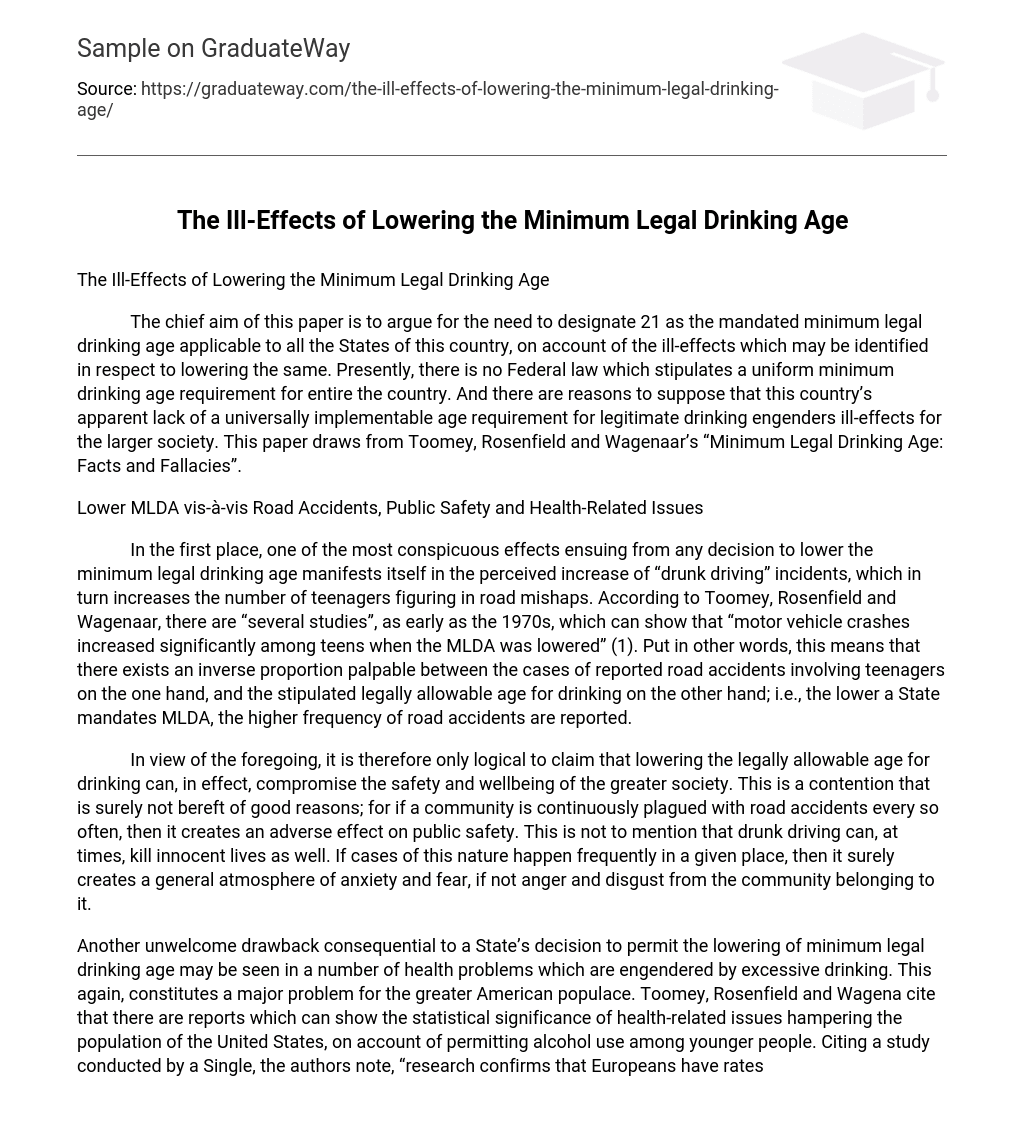The chief aim of this paper is to argue for the need to designate 21 as the mandated minimum legal drinking age applicable to all the States of this country, on account of the ill-effects which may be identified in respect to lowering the same. Presently, there is no Federal law which stipulates a uniform minimum drinking age requirement for entire the country. And there are reasons to suppose that this country’s apparent lack of a universally implementable age requirement for legitimate drinking engenders ill-effects for the larger society. This paper draws from Toomey, Rosenfield and Wagenaar’s “Minimum Legal Drinking Age: Facts and Fallacies”.
Lower MLDA vis-à-vis Road Accidents, Public Safety and Health-Related Issues
In the first place, one of the most conspicuous effects ensuing from any decision to lower the minimum legal drinking age manifests itself in the perceived increase of “drunk driving” incidents, which in turn increases the number of teenagers figuring in road mishaps. According to Toomey, Rosenfield and Wagenaar, there are “several studies”, as early as the 1970s, which can show that “motor vehicle crashes increased significantly among teens when the MLDA was lowered” (1). Put in other words, this means that there exists an inverse proportion palpable between the cases of reported road accidents involving teenagers on the one hand, and the stipulated legally allowable age for drinking on the other hand; i.e., the lower a State mandates MLDA, the higher frequency of road accidents are reported.
In view of the foregoing, it is therefore only logical to claim that lowering the legally allowable age for drinking can, in effect, compromise the safety and wellbeing of the greater society. This is a contention that is surely not bereft of good reasons; for if a community is continuously plagued with road accidents every so often, then it creates an adverse effect on public safety. This is not to mention that drunk driving can, at times, kill innocent lives as well. If cases of this nature happen frequently in a given place, then it surely creates a general atmosphere of anxiety and fear, if not anger and disgust from the community belonging to it.
Another unwelcome drawback consequential to a State’s decision to permit the lowering of minimum legal drinking age may be seen in a number of health problems which are engendered by excessive drinking. This again, constitutes a major problem for the greater American populace. Toomey, Rosenfield and Wagena cite that there are reports which can show the statistical significance of health-related issues hampering the population of the United States, on account of permitting alcohol use among younger people. Citing a study conducted by a Single, the authors note, “research confirms that Europeans have rates of alcohol-related diseases (such as cirrhosis of the liver) similar to or higher than those in the U.S. population” (2). The implication of this problem should not be underestimated; for it is axiomatic to claim that the state of the nation rests largely on the well-being of its people.
Conclusion
Hence, this paper ends with a thought which affirms its initially slated thesis statement: that it is imperative to stipulate a law which designates 21 as the legally allowable age for alcohol consumption for all the States of this country, since the effects of lowering the MLDA can be disadvantageous in the ultimate analysis. In sum, the discussions enumerated three ill-effects ensuing from lowering the MLDA – i.e., it effects (a) the perceived increase in road accidents, (b) a feeling of compromised public safety and well-being, and (c) the statistical significance of reported health-related drawbacks among many American young people.
Reference
Toomey, T., Rosenfield, C. & Wagenaar, A. “The Minimum Legal Drinking Age: Facts and Fallacies”.





